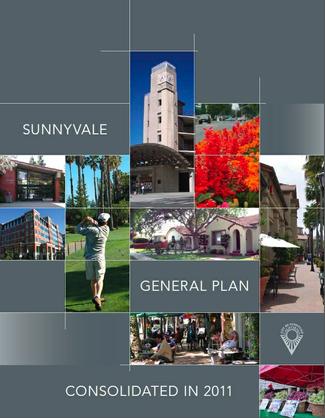
Reinventing the General Plan
A Project of the California Planning Roundtable
With support from the American Planning Association, California Chapter
Great Model: City of Sunnyvale
Featured Principles: Create a Vision, Manage Change, Prioritize Action
- Context
- Integrated Perspective
- Inclusive Vision
- Mid-Range Strategic Planning
- Continuous Monitoring
- Challenges and Lessons
- Background Information
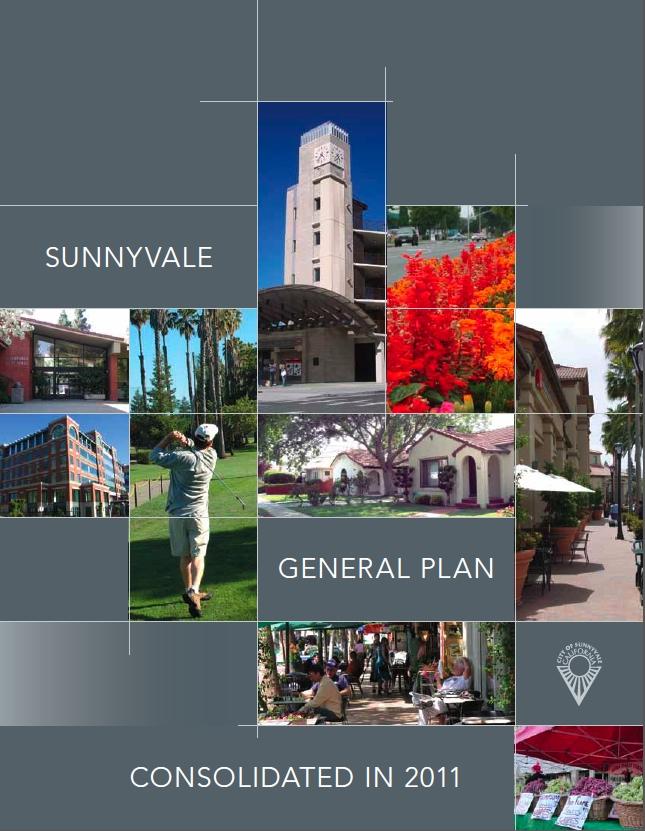
For over 40 years, the Silicon Valley City of Sunnyvale has discovered the considerable benefits of integrating general planning into overall city management, priding itself as a well-managed and well-planned community.
In Sunnyvale, the General Plan has become a tool for better management, not just a land-use plan. The Sunnyvale planning structure and process demonstrate how a General Plan can build confidence in government, while ensuring that the Plan remains relevant and current even as conditions change.
Among the strengths of the City’s planning structure:
- The General Plan is the City’s central policy document. Not just land use decisions, but every action of the City must be consistent with the General Plan.
- Sunnyvale has developed a sophisticated monitoring system to keep the Plan relevant and responsive to evolving issues, and to ensure that it is faithfully implemented. Monitoring includes Community Condition Indicators, Service Performance Indicators, and a Balanced Growth Profile.
- The planning process has been strengthened by incorporating a Community Vision, formulated by the residents and businesses of the City. A Mid-Range Strategic Planning process has also been initiated to better link current actions, strategies and budgets to the long-range goals and policies.
During the current climate of widespread cynicism and distrust of local government, residents and businesses in the City of Sunnyvale have considerable respect and confidence in the City’s governance and planning. This is due in large part to the City’s longstanding success of integrating planning with management.
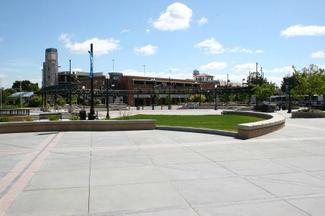
The most unique strength of the planning process in Sunnyvale is its total integration with the overall management of the City. This is not an accident, but the result of a conscious effort, over 40 years, to develop a comprehensive planning and management system.
The General Plan is the City of Sunnyvale’s central policy document, extending far beyond land use decisions. Every action of the City must be consistent with the adopted goals and policies of the General Plan. The City’s explicit differentiation of policy from operations places City Council in the proper role of formulating and adopting policy, and staff in the appropriate role of designing and operating service programs and projects consistent with that policy.
Sunnyvale has also created a sophisticated system of calculating and monitoring the quantity, quality and unit cost of every public service it delivers. The City Council does not budget by line item for personnel and materials, but rather allocates resources by desired service level (quantity and quality). The City also has a 20-year Resource Allocation Plan (financial plan), which requires that the operational and maintenance costs of any proposed new program or capital project be projected over 20 years before adoption. The system has disciplined the actions of City Council, so that an annual surplus is not squandered on some pet project, but rather squirreled away in reserves to maintain quality services in the inevitable lean years to come.
The integration of planning with management is reflected throughout the planning process. Every operating department participated in the preparation of the Plan, and the City’s management team evaluates progress in implementing the Plan on an annual basis. Linking planning with management gives city leaders a longer-range perspective, and forces planners to become more practical and action-oriented. Additionally, it ensures that the Plan will continue to be used and updated, and increases the community’s confidence in it.
For more information on the history of Sunnyvale's unique integration of planning with city management, click here (pdf).
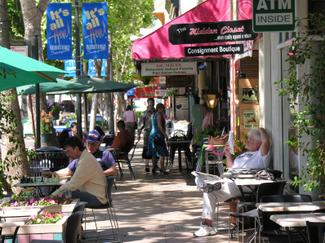
An overarching and inclusive Community Vision forms the guiding direction of Sunnyvale’s General Plan. Interestingly, this Vision is a recent development.
In 2007, after 40 years of long-range planning, Sunnyvale realized that the elements of its General Plan lacked sufficient integration and consistency because they were not guided by an overall long-range community vision. Notably, the City recognized that the vision had to come from the community itself, not from its government. The public was intensively engaged in the visioning process, and once adopted, the Sunnyvale Community Vision (pdf) gave direction to the General Plan. It also provided the goals, projections, and the basic demographic and economic data necessary to support the functional elements of the Plan.
Sunnyvale’s visioning process involved extensive community outreach. With the assistance of consultants, planners engaged the community through an online survey, small community workshops, and a large citywide visioning festival. A half-day event, the festival featured a wide-ranging brainstorming session and intensive break-out workshops, concluding with a celebratory barbeque lunch. Special efforts were made to involve Sunnyvale’s minority communities and high school youth in the process.
The first outcome of the visioning process was the creation of a clear values statement, developed by the people of Sunnyvale to articulate what they value most about their city, including a unique focus on the responsiveness of government:
Sunnyvale is an attractive, safe, environmentally sensitive community which takes pride in the diversity of its people, the innovation of its businesses, and the responsiveness of its government.
This values statement was expanded into a six-point vision statement, which was translated by staff planners into 15 long-range citywide goals, embedded into the Vision document. These goals provide the long-range context and constraints to direct the more specific goals and policies of the other General Plan elements.
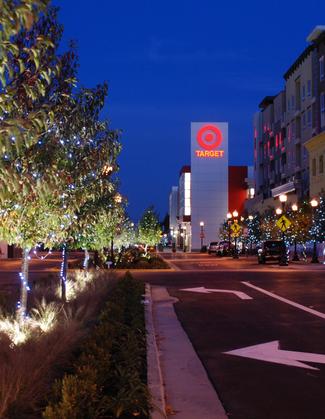
Sunnyvale recently created a mid-range strategic planning process to bridge the gap between the long-range goals of the General Plan and its day-to-day decision making. Although the planning and management process calls for all actions to be consistent with the general plan, over time Sunnyvale discovered that it had some difficulty relating current decision-making and action to long-range goals. The strategic planning process, which is to be undertaken annually by the management team, provides the vehicle to translate the long-range vision and adopted goals into mid-range action strategies.
The mid-range strategic planning process is intended to be an internal process performed by a team of the city manager and all department heads, known as the Executive Leadership Team. At one or more annual daylong retreats, the team evaluates how successfully current action strategies (programs, plans and projects) are achieving the long-range goals of the general plan. Taking into account the current economic, physical and political environment, and success in implementing General Plan goals (as reported by Community Condition Indicators and Service Performance Indicators, respectively), the team revises existing action strategies or devises new ones to be implemented over the next five years. Once formulated, these action strategies are funded through two-year operating and capital budgets, which the City Manager recommends to the City Council.
Sunnyvale’s current City Manager has extended mid-range strategic planning to include the City Council. Ideally, the Council should review adopted policies on an annual basis to ensure that they remain relevant to current economic, physical and political conditions. Once the Council has clarified or revised policies, staff can more securely proceed to revise and devise action strategies.
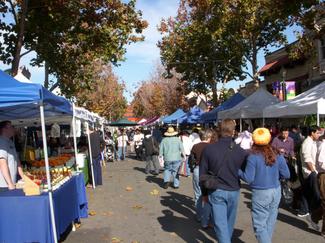
Sunnyvale continuously monitors the overall condition of the city and its success in implementing the General Plan. By nature, General Plans reflect the physical, economic, social and political conditions of the time at which they were prepared. These conditions change over time, however, making some plans outdated and ill-suited for new challenges. To address this risk, Sunnyvale utilizes a variety of indicators and other methods to track how the City is developing, and to guide adjustments to the Plan as part of the annual budgeting and strategic planning process.
First, the City monitors 88 Community Condition Indicators, mostly dealing with issues the City may influence, but does not directly control (e.g., population, jobs, retail sales, tax base, housing types and condition, and measures of environmental quality). Most of these can be measured or estimated on an annual basis from data collected by the City, County, State or Federal governments. The Indicators are used to guide the annual budgeting and strategic planning processes.
Sunnyvale also carefully tracks a large number of Service Performance Indicators. These concern matters directly under the City’s control (e.g., police response time, trash collection complaints, development permit processing time, number of senior lunches served). Data are collected by the individual operating departments and utilized by management and City Council to evaluate performance by staff in service delivery.
A third monitoring process grew out of City Council’s concern over projected population and job growth and its potential negative effects on the City’s quality of life. The Sunnyvale Community Vision devotes an entire chapter to Balanced Growth, creating a Balanced Growth Profile to assist decision-makers in maintaining a reasonable balance between population growth and job growth, and between private development and expansion of the public infrastructure necessary to support it. The Profile is in the form of a bar chart, which plots actual annual increments vs. average projected annual increments over the 20-year life of the Plan. The graphic clearly demonstrates whether jobs and infrastructure (e.g., capacities of schools, utilities, parks and transportation) are keeping up with population growth to maintain overall quality of life.
For more information on Sunnyvale's Balanced Growth Profile, click here (pdf).
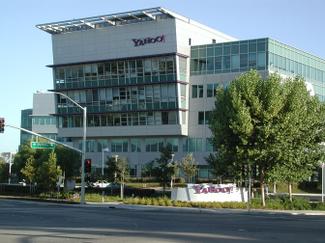
The planning and management system in Sunnyvale has been developed over a period of 40 years. It has remained relevant over this long period of time through constant reevaluation and refinement. The process was recently refreshed and streamlined; nevertheless, City staff is emphatic that the planning process is still a work in progress. Along the way, the following key lessons have been learned:
The proper roles of the public, the city council, and the staff must be clearly defined. A large part of Sunnyvale’s success is due to the clear definition and ongoing maintenance of the distinct roles of each of the participants in the process. The public’s role in the process is absolutely critical; residents must articulate a long-range vision for their community, and serve as a watchdog over the plan’s implementation by City Council and staff. The role of the City Council is to formulate and adopt policy consistent with the long-range vision and responsive to current physical, social and economic conditions. The role of staff is to implement adopted policy through the creation and management of effective programs, projects, and plans.
The process must not become more important than the product. Sophisticated, complex processes such as Sunnyvale’s planning and management system can become an end in themselves. Sunnyvale has had to constantly guard against this. Despite the obvious strengths of the system, Sunnyvale’s management staff seems to be perennially frustrated over the process. The continuous nature of the planning process, often lauded by professional planners as superior to end-state planning, can seem a repetitious burden at times (“Here we go again!”). Managers are stressed (perhaps rightfully so) by the high degree of accountability created by the management performance component of the system. This is compounded by the extensive record-keeping required. Twice over the last decade, a management task force has been convened to “streamline” the planning and management system. That streamlining was finally largely accomplished with the recent General Plan Consolidation. This constant reinvention, however, might be seen as a sign of strength rather than a sign of weakness.
The plan must not become too comprehensive. The Sunnyvale general plan grew over time into 22 elements and sub-elements, covering every aspect of government, including finance, personnel and legislative procedures. The City has now consolidated these elements into a single, six-chapter document focusing on the growth and development of the community. The consolidated plan is strongly guided by the Sunnyvale Community Vision and contains long-range goals, current policies and action strategies. The entire document is being made accessible to the public via the Internet.
A mid-range strategic planning process can bridge the gap between long-range goals and current decision-making. Although the planning and management process called for all actions to be consistent with the general plan, Sunnyvale experienced some challenges in relating day-to-day decision-making to the long-range goals of its plan. Therefore, it recently created a mid-range strategic planning process, undertaken annually by the management team, to bridge the gap. This is a new phase in the process, and has yet to be fully developed. Ideally, the mid-range strategic planning process should consist of two steps. First, the management team should review the adopted policies in the general plan, and determine if they remain relevant given current economic, physical and political conditions. Revised policies should be recommended to elected leaders, who should reformulate them and adopt them as revisions to the General Plan. The management team then develops a set of action strategies, based upon the revised general plan policies, which should be implemented through the annual adoption of budgets and preparation of departmental work programs. This establishes the critical link between the general plan and the operating and capital budgets.
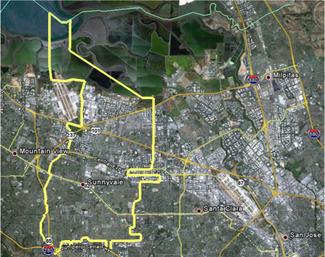
Community Description
Sunnyvale was incorporated in 1912, with a population of 1,800. It then had a small town center adjacent to the railroad station, and a gridiron pattern of nearby residential streets. Most of the 23 square miles which is now the city was then farmland, devoted primarily to fruit orchards. Subsequent decades brought industrial development, aerospace and defense production (Lockheed Martin), and most recently, high-technology information-based businesses. Today, Sunnyvale is geographically near the center of what has become known as Silicon Valley, and is home to such well known innovative companies as Yahoo!, AMD, Network Appliance, and Juniper Networks.
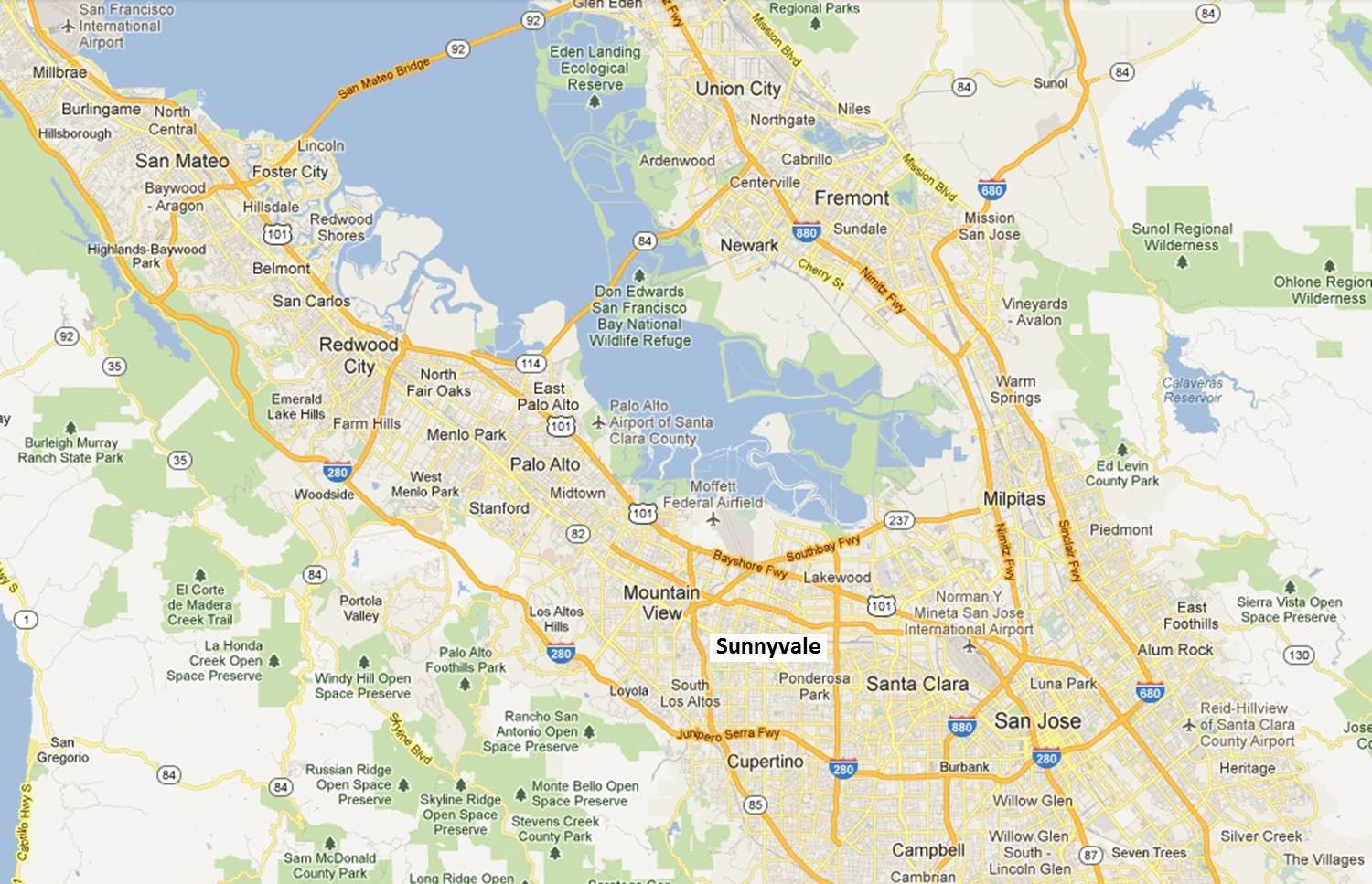
Based on the 2010 Census, the population of Sunnyvale is primarily white (43 percent) and Asian (41 percent). Two percent of the population identifies as black. Individuals who identify as Hispanic or Latino constitute about 19 percent of the City’s population.
Sunnyvale has a diverse housing stock as well, consisting of 41 percent multi-family structures, 39 percent detached single-family homes, 10 percent attached townhomes, and 7 percent mobile homes in 2006.
Location of Sunnyvale. The City of Sunnyvale is located in the southern portion of the San Francisco Bay Area in Santa Clara County. It is surrounded by Santa Clara to the east, Cupertino to the south, and Mountain View to the west. The image the right shows the boundaries of Sunnyvale in Santa Clara County.
The historic El Camino Real (Highway 82), Highway 101, and Highway 237 cross-cross to provide east-west access to the region. Interstate 280 provides additional east-west access at the southern portion of Sunnyvale and intersects Highway 85, which provides north-south access at from the southwestern corner of the City north to Highway 101.
Population and Households in Sunnyvale. The City of Sunnyvale had a population of 131,760 people in 2000. The City of Sunnyvale increased by about 8,300 people to a population of 140,081 in 2010, based on the 2010 Census.
Also, the City had a total of 53,441 housing units in 2000 and increased to a total of 55,791 housing units in 2010. This included 53,384 occupied units and 2,407 vacant units, based on the 2010 Census. The vacancy rate of Sunnyvale housing units was 4.3 percent in 2010.
The median household income (in constant 2010 dollars) in the City of Sunnyvale was $83,546 in 2005, which increased to $89,575 in 2009, based on the American Community Survey.
Housing Tenure. Forty-seven percent of the occupied housing units were owner occupied in 2000. By 2010, 48.0 percent of the housing units in the City of Sunnyvale were owner occupied, based on the 2010 Census.
Employment. According to the 2009 U.S. Census’s Longitudinal Employer-Household Dynamics data, the City of Sunnyvale had 74,831 jobs in 2009. Manufacturing and Professional, Scientific, and Technical Services formed 46.7 percent of the City’s economy in 2009. Other major sectors in the Sunnyvale economy included Health Care and Social Assistance (6.6 percent), Retail (6.5 percent) and Wholesale Trade (6.1 percent) and Accommodation and Food Services (3.7 percent).
Timeframe of Plan Development
Planning in Sunnyvale is an ongoing, continuous process. The General Plan has been developed element by element over a long period of time. The most recently adopted element was the Sunnyvale Community Vision, adopted in 2007. The City has also consolidated the 22 elements and sub-elements of its plan into a single document. The next step will be a comprehensive update of the land use and transportation chapters, which is scheduled for completion in the summer of 2012.
Keeping On Track
City Council authorized the General Plan Consolidation effort on October 20, 2009. The consolidated plan was adopted on July 26, 2011, only one month beyond the intended 18-month schedule.
Overall Vision of Plan
The thrust of Sunnyvale’s program is to integrate long-range planning and overall city management. The vision for the plan, as stated in the Sunnyvale Community Vision, is:
Sunnyvale is an attractive, safe, environmentally sensitive community which takes pride in the diversity of its people, the innovation of its businesses, and the responsiveness of its government.
Public Participation and Stakeholder Involvement
Sunnyvale’s visioning process involved extensive community outreach. The community was engaged through an on-line survey, small community workshops, and a large citywide visioning festival. Special efforts were made to involve Sunnyvale’s minority communities and high school youth in the process. The festival was a half-day event, which included a large brainstorming session and intensive break-out workshops.
The recent consolidation of the General Plan was supported by a General Plan Consolidation Advisory Committee. The Committee consisted of one representative from each City board and commission (selected by the board or commission) and two members of City Council. The Committee met six times. In addition, the Committee held a larger community outreach meeting. Articles in the City’s Quarterly Report (mailed to all residences and businesses) encouraged the public to keep up to date with the effort by checking a General Plan Consolidation website.
Other City/County Departments' Involvement
One of the strengths of the Sunnyvale planning process is the involvement of all of the operating departments in the preparation of the plan and the monitoring of its implementation. Each element was prepared by the department responsible for its implementation, with the guidance of planners from the Community Development Department.
For the General Plan Consolidation effort, a Staff Task Force was assembled representing departments with major pieces of the current General Plan, including Public Safety, Community Services (formerly Parks and Recreation), Public Works, Community Development and the Office of the City Manager. The Staff Task Force assisted in researching the decision points and making preliminary recommendations to the Advisory Committee. Staff prepared background information on each topic, reviewed award-winning comprehensive General Plans, and conducted a series of stakeholder interviews about the use of the General Plan. This information was presented to the Advisory Committee to assist in their recommendations.
Legal and Policy Context
The General Plan meets all of the requirements of California planning law. Its policy context, however, is much broader than State-mandated general plan requirements, designed to meet the ongoing management needs of the community.
Consideration of Regional Issues
There was little need for regional consultation in the consolidation effort. Extensive cooperation with regional agencies is anticipated in the upcoming update of the land use and transportation chapters.
Community Reaction
The residents and businesses of Sunnyvale have consistently, over the years, demonstrated trust and respect for their local government. This is due largely to the successful integration of planning and city management.
Implementation Features
The General Plan is Sunnyvale’s central policy document. The Plan sets forth long-range goals and policies for development and management of the City. Action Strategies (programs, projects and development plans) are developed by the management team through the mid-range strategic planning process to implement the goals and policies of the Plan. These are endorsed by the City Council through the adoption of the operating and capital budgets. The annual work programs for each department, and for each manager within every department, are designed to implement the action strategies. Management performance is evaluated annually based upon success in achieving the work programs.
Connection to Jurisdictional Budget
As described in the preceding paragraph, the Plan is directly linked to the operating and capital budgets through the mid-range strategic planning process.
Adaptability
Sunnyvale’s comprehensive monitoring process, including Community Condition Indicators, Service Performance Indicators, and the Balanced Growth Profile, provides the intelligence necessary to annually review and update the policies of the Plan and the Action Strategies to implement it.
Accessibility
Accessibility of the Plan to the public has long been a weakness of the Sunnyvale planning effort. This was corrected in the recent General Plan Consolidation effort, wherein the consolidation process and the Draft Consolidated General Plan were available via the Internet. The adopted consolidated plan is now readily accessible on the Internet.
Organization
The original Plan consisted of 22 elements and sub-elements adopted over several decades. The Consolidated General Plan, adopted in July 2011, consists of the following six chapters: Vision, Land Use and Transportation, Community Character, Housing and Economy, Safety and Health, and Environmental Management.
Costs
While the overall costs of the planning program are difficult to gauge, the cost for developing the Sunnyvale Community Vision was approximately $131,000, including $65,000 in consultant fees, $55,000 in staff costs, and $11,000 in printing. The budgeted cost for General Plan Consolidation was $50,000 in staff time.
Actual Costs vs. Expected Costs
The actual cost has not exceeded the budgeted cost.
Adoption Process
Although the General Plan elements were created over several decades, the City Council adopted a Consolidated General Plan on July 26, 2011.
CEQA Review
Because the consolidation process involved no substantial new policy, a Negative Declaration was prepared.
Planning Staff and Consultants
Hanson Hom, Director of Community Development
Trudi Ryan, Planning Officer
Diana O’Dell, Senior Planner
John Verducci, Graphic Artist
Moore Iacofano Goltsman, consultants for the Sunnyvale Community Vision
Accessing the Plan
The Consolidated General Plan is available on the web at: http://sunnyvale.ca.gov/CodesandPolicies/GeneralPlan.aspx.
Name of CPR Preparer(s) of this Model
Robert Paternoster, FAICP, Planning Consultant
Stanley R. Hoffman, FAICP, Economic Consultant and CPR Member
Name of Primary Point(s) of Contact at the Jurisdiction
Trudi Ryan, Planning Officer
Date Reviewed by Jurisdiction
10/10/2011
CPR Peer Reviewers
David Booher, FAICP; Linda Dalton, AICP; Al Zelinka, FAICP
CPR Project Team
Elaine Costello, FAICP, Project Manager; Project Co-Chairs Cathy Creswell and Janet Ruggiero, FAICP; Craig Beebe, Project Assistant
Funding
California Chapter of the American Planning Association
The Catalog
Our catalog contains a number of General Plan "Great Model" examples. Browse the entire catalog
Browse by Principle
- Create a Vision
- Manage Change
- Make Life Better
- Build Community Identity
- Promote Social Equity and Economic Prosperity
- Steward and Enhance the Environment
- Engage the Whole Community
- Look Beyond Local Boundaries
- Prioritize Action
- Be Universally Attainable
Browse by tag:
awards city climate-change context county equity graphics growth-management health implementation infill mature-community organization participation preservation redevelopment region rural smart-growth suburban sustainability town urban urban-design web-strategies
